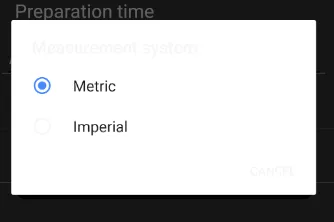我正在尝试改变ListPreference弹出对话框的样式,就像我在这个answer中看到的那样。例如,我想为对话框设置不同的背景颜色。
到目前为止,我尝试使用以下方式应用我的自定义样式:
<item name="android:dialogTheme">@style/AlertDialogStyle</item>
<item name="android:alertDialogTheme">@style/AlertDialogStyle</item>
<item name="android:alertDialogStyle">@style/AlertDialogStyle</item>
<item name="android:dialogPreferenceStyle">@style/AlertDialogStyle</item>
<style name="AlertDialogStyle" parent="AlertDialog.AppCompat">
<item name="colorPrimary">@color/colorPrimary</item>
<item name="colorPrimaryDark">@color/colorPrimaryDark</item>
<item name="colorAccent">@color/colorAccent</item>
<item name="android:textColor">@color/lightGrey</item>
<item name="android:background">@color/cardBackground</item>
<item name="android:popupBackground">@color/cardBackground</item>
<item name="android:windowBackground">@color/cardBackground</item>
<item name="android:itemBackground">@color/cardBackground</item>
</style>
但我的风格仍未应用,背景颜色未更改。
这是目前我的ListPreference弹出对话框的样子:
这就是我想要实现的颜色主题(基本上与我在其他对话框中使用的主题相同):
为了快速重现我的问题 -> 我的项目在github上。

